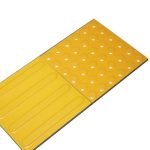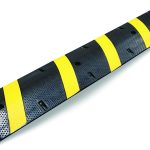Introduction to speed bumps
Speed bumps are a common traffic calming measure used in high-traffic areas to reduce vehicle speeds and improve safety. They are typically raised sections of road that force drivers to slow down as they pass over them. The purpose of speed bumps is to encourage drivers to drive at a safe speed, especially in areas where there are pedestrians or other vulnerable road users. In this article, we will explore various speed bump solutions that can be implemented in high-traffic areas to effectively manage and control vehicle speeds.
Importance of speed bumps in high-traffic areas
Speed bumps play a crucial role in ensuring safety and regulating traffic flow in high-traffic areas. These traffic calming devices are strategically placed to slow down vehicles, reducing the risk of accidents and promoting pedestrian safety. By forcing drivers to reduce their speed, speed bumps help to prevent reckless driving and encourage responsible behavior on the road. Additionally, speed bumps are effective in controlling traffic congestion, as they create a natural barrier that limits the speed and volume of vehicles passing through. Overall, the importance of speed bumps in high-traffic areas cannot be overstated, as they contribute significantly to maintaining order, enhancing safety, and improving the overall quality of the driving experience.
Benefits of implementing speed bump solutions
Implementing speed bump solutions in high-traffic areas offers several benefits. Firstly, it helps in reducing the speed of vehicles, ensuring the safety of pedestrians and other road users. Speed bumps also act as a visual reminder for drivers to slow down and be cautious. Additionally, they can help in controlling traffic flow, preventing accidents, and minimizing vehicle noise. Moreover, speed bumps are cost-effective and relatively easy to install, making them an efficient solution for improving road safety. Overall, implementing speed bump solutions in high-traffic areas can significantly enhance the overall safety and efficiency of the road network.
Types of Speed Bumps
Traditional speed bumps
Traditional speed bumps have been widely used as a traffic calming measure in high-traffic areas. These speed bumps are typically made of asphalt or concrete and are designed to slow down vehicles by creating a sudden jolt or vibration. They are usually installed in residential areas, school zones, and parking lots to reduce vehicle speeds and improve safety for pedestrians and other road users. While traditional speed bumps have proven to be effective in reducing speed, they can also cause discomfort and inconvenience for drivers. Additionally, they may not be suitable for certain types of vehicles, such as emergency vehicles or vehicles with low ground clearance. As a result, alternative speed bump solutions have been developed to address these limitations and provide a more comfortable and efficient traffic calming option.
Speed humps
Speed humps are a common solution for managing speed in high-traffic areas. These raised platforms are typically made of asphalt or concrete and are designed to slow down vehicles by forcing them to reduce their speed. Speed humps are strategically placed along roads to encourage drivers to drive at a safe and controlled speed, reducing the risk of accidents and improving overall road safety. They are particularly effective in residential areas, school zones, and other locations where pedestrian safety is a top priority. By implementing speed humps, communities can create a safer environment for both drivers and pedestrians alike.
Rubberized speed cushions
Rubberized speed cushions are an effective solution for managing traffic speed in high-traffic areas. These traffic calming devices are designed to slow down vehicles by providing a series of raised cushions on the road surface. The rubberized material used in the construction of these speed cushions offers several benefits. It helps to reduce noise pollution caused by vehicles passing over them, making them a popular choice for residential areas. Additionally, the rubberized surface provides better traction, ensuring the safety of both drivers and pedestrians. Rubberized speed cushions are a cost-effective and durable solution that can effectively control vehicle speed and improve road safety in high-traffic areas.
Factors to Consider
Traffic volume and speed
Traffic volume and speed are important factors to consider when exploring portable speed bumps solutions for high-traffic areas. High traffic volume combined with high speeds can create hazardous conditions for both drivers and pedestrians. Speed bumps are designed to help reduce speed and improve safety by forcing drivers to slow down. By strategically placing speed bumps in areas with high traffic volume and excessive speeding, we can effectively control and regulate the flow of traffic, ultimately reducing the risk of accidents and promoting a safer environment for everyone.
Road conditions
Road conditions play a crucial role in ensuring the safety and efficiency of high-traffic areas. It is imperative to have a thorough understanding of the existing road conditions before implementing speed bump solutions. Factors such as the quality of the road surface, visibility, and traffic flow need to be taken into consideration. By assessing these conditions, appropriate speed bump designs can be chosen to effectively control vehicle speed and minimize the risk of accidents. Additionally, regular maintenance and monitoring of road conditions are essential to ensure the longevity and effectiveness of the speed bump solutions.
Impact on emergency vehicles
One important aspect to consider when implementing speed bumps in high-traffic areas is their impact on emergency vehicles. While speed bumps can effectively reduce the speed of regular vehicles, they can also pose challenges for emergency vehicles that need to respond quickly to emergencies. The presence of speed bumps can potentially delay response times, especially if emergency vehicles have to slow down significantly or navigate carefully to avoid damaging their vehicles. Therefore, it is crucial to carefully plan the placement and design of speed bumps in such areas to minimize any negative impact on the ability of emergency vehicles to reach their destinations swiftly and safely.
Design and Placement
Proper dimensions and materials
When it comes to speed bump solutions for high-traffic areas, one of the key factors to consider is the proper dimensions and materials. The dimensions of a speed bump should be carefully chosen to ensure that it effectively slows down vehicles without causing any damage or discomfort. The height, width, and length of the speed bump should be in accordance with industry standards and regulations. Additionally, the materials used in the construction of the speed bump should be durable and able to withstand heavy traffic and varying weather conditions. Common materials for speed bumps include rubber, asphalt, and concrete. Each material has its own advantages and disadvantages, so it is important to select the one that best suits the specific needs of the area. By choosing the proper dimensions and materials for speed bumps, high-traffic areas can be made safer and more efficient for both pedestrians and drivers.
Ideal locations for speed bumps
Speed bumps are an effective traffic calming measure that can be strategically placed in high-traffic areas to ensure the safety of pedestrians and drivers. When considering ideal locations for speed bumps, it is important to take into account factors such as the speed limit, road conditions, and the presence of schools or residential areas. High-traffic areas near schools or residential neighborhoods are particularly suitable for speed bumps, as they help to reduce vehicle speeds and protect vulnerable road users. Additionally, speed bumps can be placed near intersections or crosswalks to encourage drivers to slow down and yield to pedestrians. By strategically placing speed bumps in these ideal locations, we can create safer and more livable communities for everyone.
Considerations for visibility and signage
When considering speed bump solutions for high-traffic areas, it is crucial to pay attention to visibility and signage. Ensuring that speed bumps are easily visible to drivers is essential for their effectiveness. This can be achieved by using bright colors or reflective materials to make them stand out. Additionally, proper signage should be installed to alert drivers of the presence of speed bumps ahead. Clear and informative signs can help prevent accidents and ensure that drivers slow down when approaching the speed bumps. By prioritizing visibility and signage, communities can create safer roads for both drivers and pedestrians.
Effectiveness and Limitations
Reduction in speeding incidents
One of the key benefits of implementing speed bumps in high-traffic areas is the reduction in speeding incidents. Speed bumps are designed to slow down vehicles, forcing drivers to reduce their speed. This helps to create a safer environment for pedestrians and other road users. By effectively slowing down traffic, speed bumps can significantly decrease the number of speeding incidents, making the area more secure and minimizing the risk of accidents. Moreover, speed bumps serve as a visual reminder for drivers to adhere to the designated speed limit, promoting responsible driving behavior and enhancing overall road safety.
Impact on traffic flow
Speed bumps have a significant impact on traffic flow in high-traffic areas. These traffic calming measures are designed to slow down vehicles, ensuring the safety of pedestrians and reducing the risk of accidents. However, they can also cause delays and congestion, especially during peak hours. While speed bumps are effective in reducing speeding and promoting safer driving habits, their presence can disrupt the smooth flow of traffic. It is important for city planners and traffic engineers to carefully consider the placement and design of speed bumps to minimize their negative effects on traffic flow.
Potential drawbacks and challenges
While speed bumps can be an effective solution for managing high traffic areas, there are potential drawbacks and challenges that need to be considered. One of the main drawbacks is the impact on vehicle suspension and wear and tear. Speed bumps can cause discomfort for drivers and may result in damage to vehicles if not properly designed and maintained. Additionally, speed bumps can contribute to noise pollution, especially in residential areas. Another challenge is the potential for reduced emergency vehicle response times. Speed bumps can slow down emergency vehicles, which can be critical in life-threatening situations. Therefore, it is important to carefully evaluate the need for speed bumps and consider alternative traffic calming measures that may be more suitable for the specific area.
Conclusion
Summary of speed bump solutions
Speed bumps are an effective traffic calming measure used in high-traffic areas to reduce vehicle speed and improve safety. They are designed to slow down vehicles by creating a raised surface on the road. There are several types of speed bump solutions available, including traditional speed bumps, speed humps, and speed cushions. Traditional speed bumps are typically made of asphalt or concrete and are characterized by their height and steepness. Speed humps, on the other hand, are longer and have a gradual slope, allowing vehicles to maintain a higher speed while still reducing their overall speed. Speed cushions are similar to speed humps but have cutouts to accommodate the tires of emergency vehicles. Each type of speed bump solution has its own advantages and disadvantages, and the choice of which to use depends on various factors such as traffic volume, speed limits, and road conditions. Overall, implementing speed bump solutions in high-traffic areas can help promote safer driving habits and enhance the overall traffic flow.
Importance of careful planning and evaluation
When it comes to implementing speed bump solutions in high-traffic areas, careful planning and evaluation are of utmost importance. These measures are necessary to ensure that the chosen solutions are effective in reducing speed and improving overall safety. Before installing any speed bumps, it is crucial to assess the specific needs and characteristics of the area, such as traffic volume, vehicle types, and road conditions. This information will help determine the appropriate size, design, and placement of the speed bumps. Additionally, conducting a thorough evaluation after installation is essential to monitor their effectiveness and make any necessary adjustments. By prioritizing careful planning and evaluation, communities can implement speed bump solutions that effectively address the unique challenges of high-traffic areas and enhance road safety.
Future considerations for improving traffic safety
In addition to the speed bump solutions discussed earlier, there are several future considerations that can be explored to further improve traffic safety in high-traffic areas. One such consideration is the implementation of smart traffic lights that can adjust their timing based on real-time traffic conditions. This can help to reduce congestion and improve the flow of traffic, ultimately enhancing safety for both drivers and pedestrians. Additionally, the use of advanced technology such as automated enforcement systems can help to deter speeding and other traffic violations. These systems can capture and issue citations to drivers who exceed the speed limit or run red lights, promoting safer driving behavior. Furthermore, investing in improved road signage and markings can also contribute to better traffic safety. Clear and visible signs, along with well-painted road markings, can provide drivers with important information and guidance, reducing the risk of accidents. By considering these future solutions, we can make significant strides in enhancing traffic safety in high-traffic areas.









